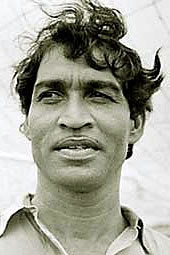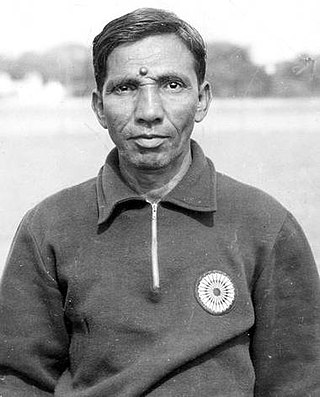
Sailendra Nath Manna, known popularly as Sailen Manna, was an Indian football player who represented the India national team between 1948 and 1956. Predominantly played as a left-back, Manna is considered as one of the best defenders the country has ever produced. He has represented and captained India in different international competitions, including the Olympics and Asian Games. In 1971 Manna was awarded with Padma Shri by Government of India.

Subimal "Chuni" Goswami was an Indian professional footballer and first-class cricketer. As footballer, he played as a striker or winger, captained both the Mohun Bagan club and the India national team. He also served as the Sheriff of Kolkata. Goswami scored 12 goals in 37 international appearances. He was an Olympian, represented India national team at the 1960 Summer Olympics. He also led the team to achieve the gold medal at the 1962 Asian Games, and earn the runners-up position at the 1964 AFC Asian Cup.
Yousuf Khan was an Indian footballer who represented India national team at the 1960 Summer Olympics. He was one of only two Indians to have been included in the 1965 Asian All Stars XI. He was also a part of the team which won the 1962 Asian Games.

Pradip Kumar BanerjeeFIFAOM was an Indian professional footballer who played as a striker for the India national football team. He also captained the national team and later on became the coach of the national team. He represented India in 52 official matches and scored 16 official goals for the country. He was one of the first recipients of Arjuna Award, when the awards were instituted in 1961. He was awarded the prestigious Padma Shri in 1990 and was named Indian Footballer of the 20th century by IFFHS. In 2004, he was awarded the FIFA Order of Merit, the highest honour awarded by FIFA.

Syed Nayeemuddin, known as Nayeem, is an Indian football coach and former player. He played for and captained the India national team. He later managed Mahindra United, Brothers Union, Dhaka Mohammedan, and Bangladesh national team.

Havildar Peter Thangaraj was an Indian football player and a non-commissioned officer in the Indian Army. Thangaraj played for the Indian national side at the 1956 Melbourne and 1960 Rome Olympics. He was voted Asia's best goalkeeper in 1958. Thangaraj was a recipient of Arjuna Award for the year 1967.

Neville Steven Joseph D'Souza was an Indian footballer who played as a striker. During the "golden era of Indian football" under legendary coach Syed Abdul Rahim, he was recognised one of the finest strikers of India national team having perfect eye for goal. He appeared in the 1956 Summer Olympics, and finished the campaign as joint top scorer of the tournament with four goals, inducing a hat-trick in the quarterfinals against the hosts Australia.

T. Abdul Rahman, also known as Olympian Rahman, was an Indian football defender from Kozhikode, Kerala, who represented the country at the Summer Olympics. He played as a defender. Abdul Rahman was a member of the Indian football team that reached the semi-final in the 1956 Melbourne Olympics.

Mariappa Kempaiah was an Indian professional footballer who played as a midfielder. He played for the India national team at two Olympic Games. Known for his "fitness, work rate and commitment", he was considered one of India's best midfielders.

Syed Abdul Rahim, popularly known as Rahim Saab, was an Indian football coach and manager of the India national team from 1950 until his death in 1963, and a former player. He is regarded as the architect of modern Indian football. A teacher by profession, he was a strong motivator and his tenure as a coach is regarded as the "golden age" of football in India.

Samar "Badru" Banerjee was an Indian footballer who played primarily as a striker for the India national football team. He captained India at the 1956 Summer Olympics in Melbourne, where they achieved fourth place.
Hyderabad City Police Football Club was an Indian institutional football club, being the most famous and powerful team in Hyderabad, affiliated to the Hyderabad Football Association (HFA). The club was associated and affiliated with Hyderabad City Police during reign of the Nizam of Hyderabad. From 1939 until the merger of Andhra, and Hyderabad Football Associations, the club shaped the sporting culture in the province.

Tulsidas Balaram, also known as Tulsidas Balaraman, was an Indian footballer. Balaram represented India in multiple international tournaments, including the Asian Games, the Mederka Cup and the Olympics. Along with P. K. Banerjee and Chuni Goswami, Balaram was part of an acclaimed trio of players that helped propel India into what is widely regarded as its golden age of football during the 1950s and 60s.

O. Chandrasekhar Menon was an Indian professional footballer who played as a defender. He represented India at the 1960 Summer Olympics (Rome), the 1962 Asian Games, 1964 AFC Asian Cup, Merdeka Tournament and 1964 Summer Olympics.
Jarnail Singh Dhillon was a former Indian football player, who played as a centre-back. He was the captain of the India national football team from 1965 to 1967. He was given the Arjuna Award in 1964 for his achievements as a football player. He also competed in the men's tournament at the 1960 Summer Olympics. Considered as one of Asia's best defenders in the 1960s, he spent most of his career in Mohun Bagan.
J. Krishnaswamy, also known as Krishna "Kittu", was a former footballer who represented India as a forward at the 1956 Summer Olympics, where he scored once. He was vice-captain of the national team.
Sheikh Abdul Latif was an Indian footballer. He participated at the 1952 Summer Olympics, 1956 Summer Olympics and the 1960 Summer Olympics, with Syed Abdul Rahim managed India. In 1959–60, he captained the national team.
Sayed Khwaja Aziz-ud-Din, known simply as S. K. Azizuddin, was an Indian footballer. He competed at the 1952 Summer Olympics and the 1956 Summer Olympics. He also captained the national team.

Mohammed Zulfiqaruddin was an Indian association football player who played for the India national football team. He was part of the Indian team that reached the Semi-final of 1956 Summer Olympics.

Mohammad Rahmatullah was an Indian footballer who played as a forward, and manager.















